Social Innovation and Community Engagement Report: ADHF Analysis
VerifiedAdded on 2023/06/04
|11
|2412
|431
Report
AI Summary
This report delves into the concepts of social innovation and community engagement, using the Australia Dental Health Foundation (ADHF) as a case study. It begins with an executive summary, followed by a discussion of social innovation and community engagement theory. The core of the report proposes a social innovation, the Dry Tooth-brushing Program, designed for educational institutions lacking proper hygiene facilities. The report outlines the program's significance and its contribution to the common good. A comprehensive SWOT and PESTLE analysis of ADHF is provided, along with a discussion of potential funding sources and ethical implications. The report also addresses implementation challenges and concludes by emphasizing the importance of community participation in achieving the program's long-term goals. The report utilizes academic resources and provides a detailed examination of the program's potential impacts on oral health within the community.
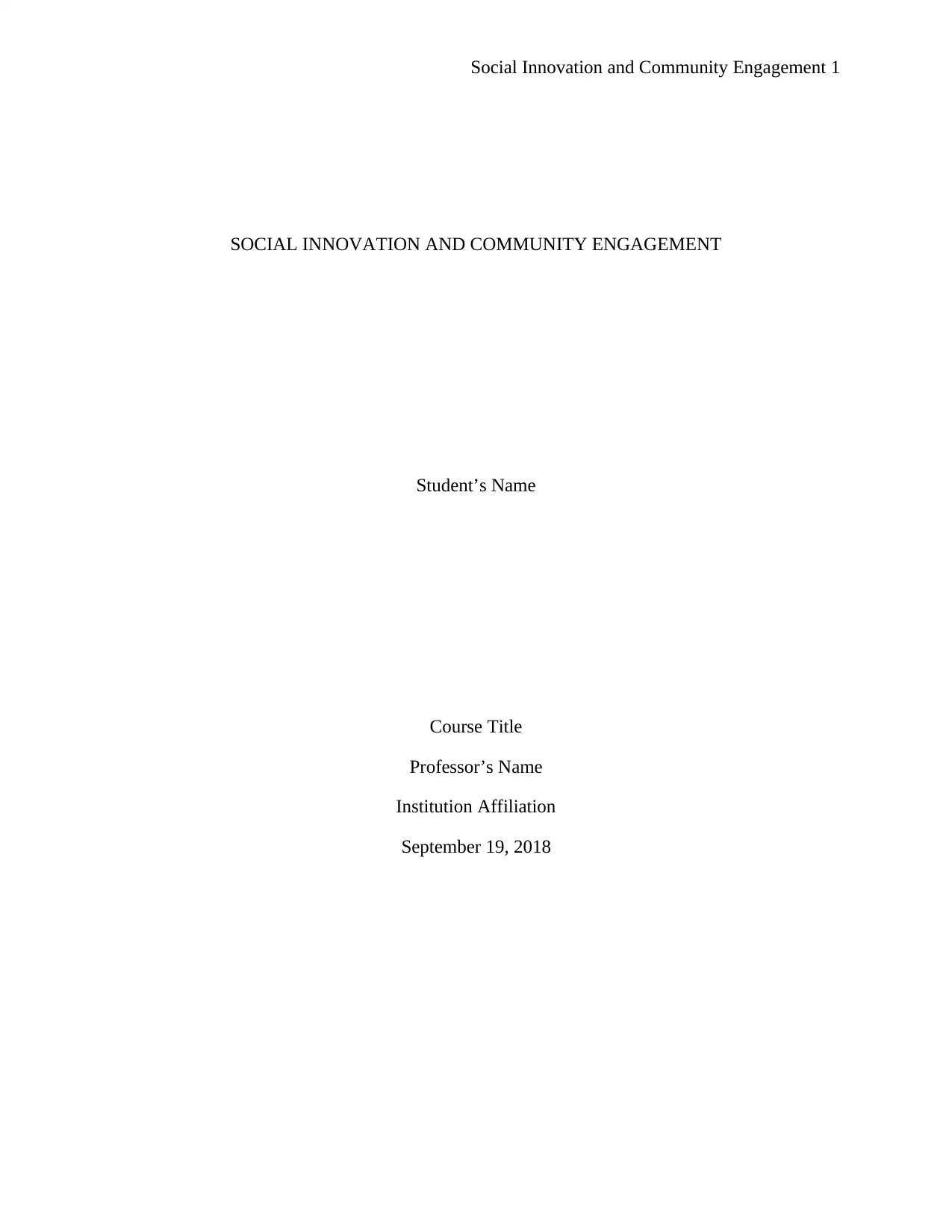
Social Innovation and Community Engagement 1
SOCIAL INNOVATION AND COMMUNITY ENGAGEMENT
Student’s Name
Course Title
Professor’s Name
Institution Affiliation
September 19, 2018
SOCIAL INNOVATION AND COMMUNITY ENGAGEMENT
Student’s Name
Course Title
Professor’s Name
Institution Affiliation
September 19, 2018
Paraphrase This Document
Need a fresh take? Get an instant paraphrase of this document with our AI Paraphraser
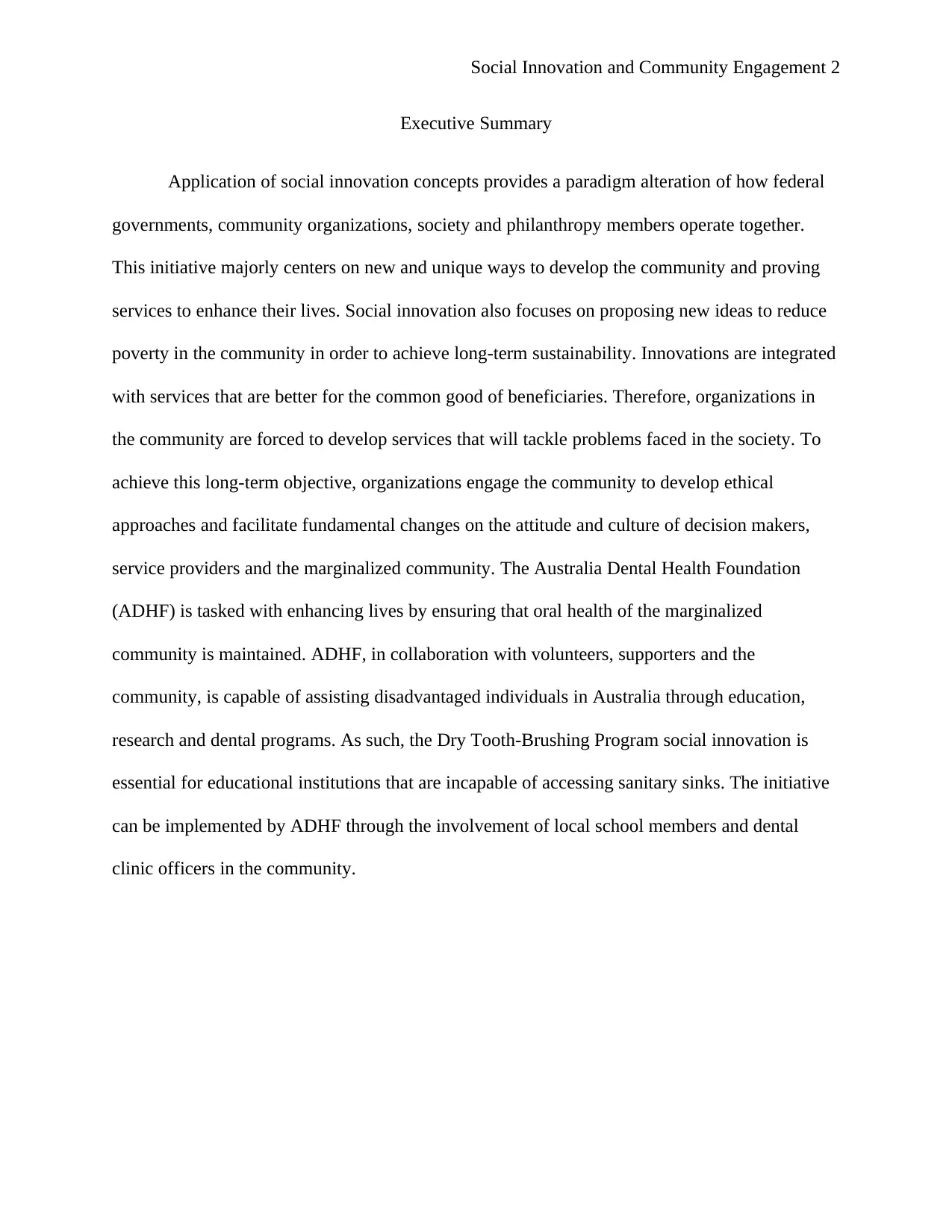
Social Innovation and Community Engagement 2
Executive Summary
Application of social innovation concepts provides a paradigm alteration of how federal
governments, community organizations, society and philanthropy members operate together.
This initiative majorly centers on new and unique ways to develop the community and proving
services to enhance their lives. Social innovation also focuses on proposing new ideas to reduce
poverty in the community in order to achieve long-term sustainability. Innovations are integrated
with services that are better for the common good of beneficiaries. Therefore, organizations in
the community are forced to develop services that will tackle problems faced in the society. To
achieve this long-term objective, organizations engage the community to develop ethical
approaches and facilitate fundamental changes on the attitude and culture of decision makers,
service providers and the marginalized community. The Australia Dental Health Foundation
(ADHF) is tasked with enhancing lives by ensuring that oral health of the marginalized
community is maintained. ADHF, in collaboration with volunteers, supporters and the
community, is capable of assisting disadvantaged individuals in Australia through education,
research and dental programs. As such, the Dry Tooth-Brushing Program social innovation is
essential for educational institutions that are incapable of accessing sanitary sinks. The initiative
can be implemented by ADHF through the involvement of local school members and dental
clinic officers in the community.
Executive Summary
Application of social innovation concepts provides a paradigm alteration of how federal
governments, community organizations, society and philanthropy members operate together.
This initiative majorly centers on new and unique ways to develop the community and proving
services to enhance their lives. Social innovation also focuses on proposing new ideas to reduce
poverty in the community in order to achieve long-term sustainability. Innovations are integrated
with services that are better for the common good of beneficiaries. Therefore, organizations in
the community are forced to develop services that will tackle problems faced in the society. To
achieve this long-term objective, organizations engage the community to develop ethical
approaches and facilitate fundamental changes on the attitude and culture of decision makers,
service providers and the marginalized community. The Australia Dental Health Foundation
(ADHF) is tasked with enhancing lives by ensuring that oral health of the marginalized
community is maintained. ADHF, in collaboration with volunteers, supporters and the
community, is capable of assisting disadvantaged individuals in Australia through education,
research and dental programs. As such, the Dry Tooth-Brushing Program social innovation is
essential for educational institutions that are incapable of accessing sanitary sinks. The initiative
can be implemented by ADHF through the involvement of local school members and dental
clinic officers in the community.
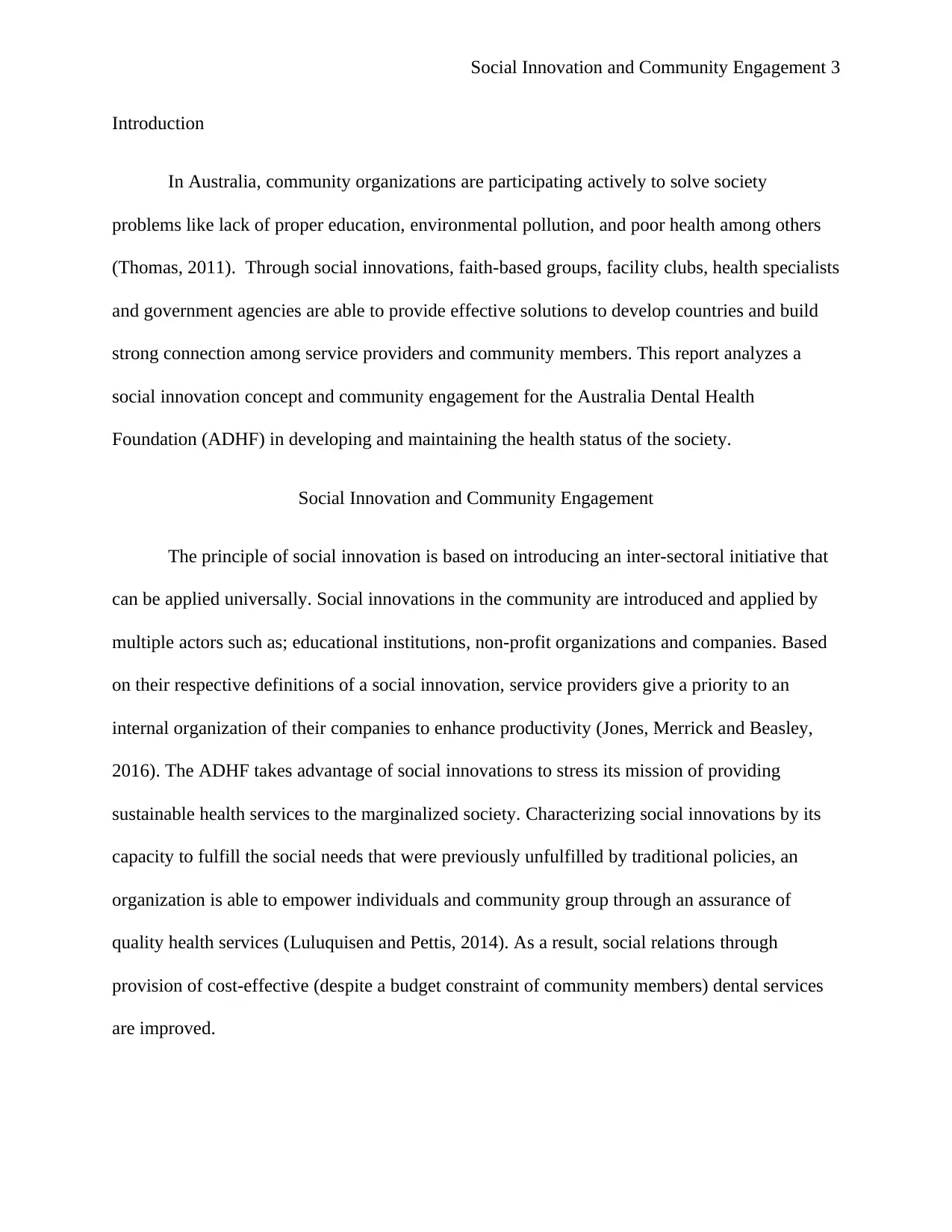
Social Innovation and Community Engagement 3
Introduction
In Australia, community organizations are participating actively to solve society
problems like lack of proper education, environmental pollution, and poor health among others
(Thomas, 2011). Through social innovations, faith-based groups, facility clubs, health specialists
and government agencies are able to provide effective solutions to develop countries and build
strong connection among service providers and community members. This report analyzes a
social innovation concept and community engagement for the Australia Dental Health
Foundation (ADHF) in developing and maintaining the health status of the society.
Social Innovation and Community Engagement
The principle of social innovation is based on introducing an inter-sectoral initiative that
can be applied universally. Social innovations in the community are introduced and applied by
multiple actors such as; educational institutions, non-profit organizations and companies. Based
on their respective definitions of a social innovation, service providers give a priority to an
internal organization of their companies to enhance productivity (Jones, Merrick and Beasley,
2016). The ADHF takes advantage of social innovations to stress its mission of providing
sustainable health services to the marginalized society. Characterizing social innovations by its
capacity to fulfill the social needs that were previously unfulfilled by traditional policies, an
organization is able to empower individuals and community group through an assurance of
quality health services (Luluquisen and Pettis, 2014). As a result, social relations through
provision of cost-effective (despite a budget constraint of community members) dental services
are improved.
Introduction
In Australia, community organizations are participating actively to solve society
problems like lack of proper education, environmental pollution, and poor health among others
(Thomas, 2011). Through social innovations, faith-based groups, facility clubs, health specialists
and government agencies are able to provide effective solutions to develop countries and build
strong connection among service providers and community members. This report analyzes a
social innovation concept and community engagement for the Australia Dental Health
Foundation (ADHF) in developing and maintaining the health status of the society.
Social Innovation and Community Engagement
The principle of social innovation is based on introducing an inter-sectoral initiative that
can be applied universally. Social innovations in the community are introduced and applied by
multiple actors such as; educational institutions, non-profit organizations and companies. Based
on their respective definitions of a social innovation, service providers give a priority to an
internal organization of their companies to enhance productivity (Jones, Merrick and Beasley,
2016). The ADHF takes advantage of social innovations to stress its mission of providing
sustainable health services to the marginalized society. Characterizing social innovations by its
capacity to fulfill the social needs that were previously unfulfilled by traditional policies, an
organization is able to empower individuals and community group through an assurance of
quality health services (Luluquisen and Pettis, 2014). As a result, social relations through
provision of cost-effective (despite a budget constraint of community members) dental services
are improved.
⊘ This is a preview!⊘
Do you want full access?
Subscribe today to unlock all pages.

Trusted by 1+ million students worldwide
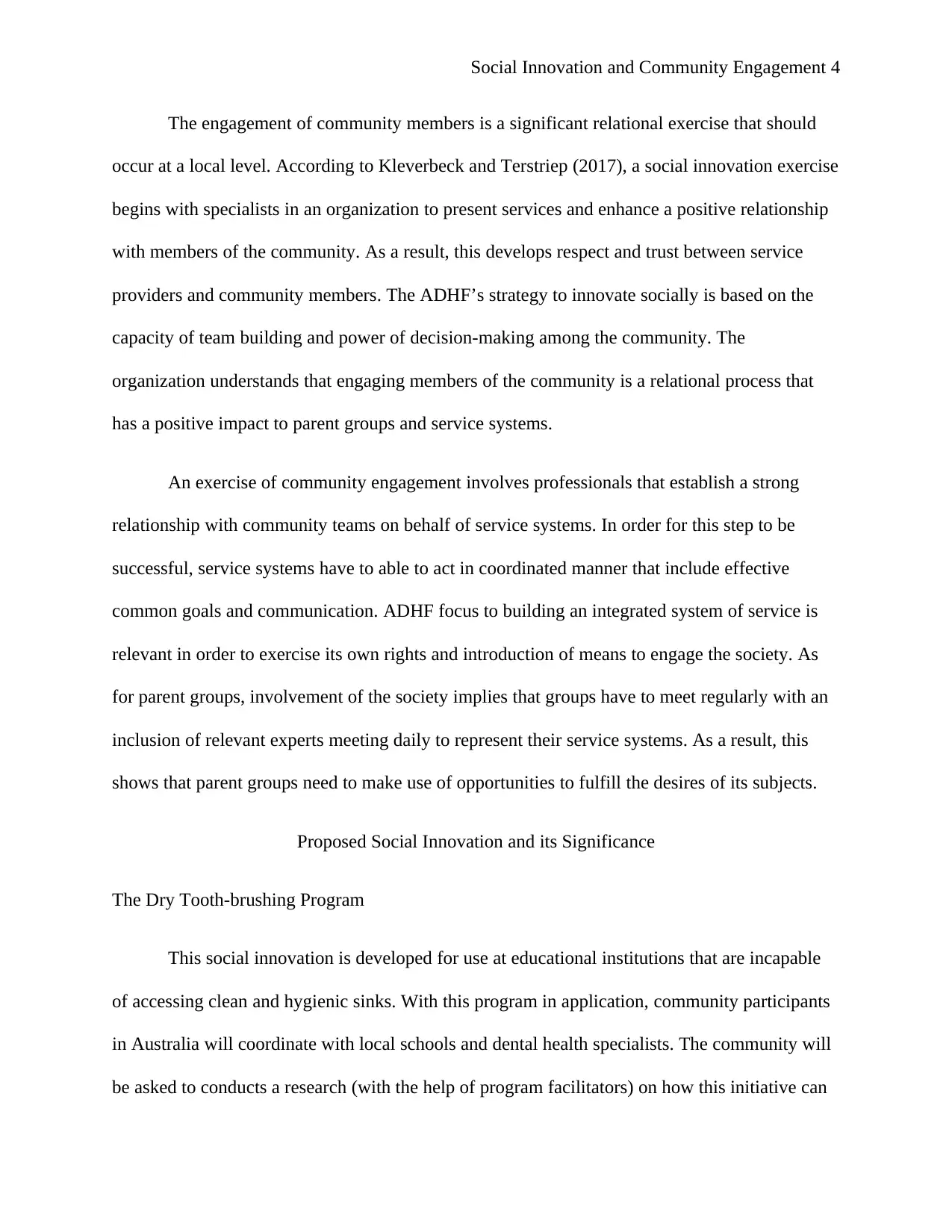
Social Innovation and Community Engagement 4
The engagement of community members is a significant relational exercise that should
occur at a local level. According to Kleverbeck and Terstriep (2017), a social innovation exercise
begins with specialists in an organization to present services and enhance a positive relationship
with members of the community. As a result, this develops respect and trust between service
providers and community members. The ADHF’s strategy to innovate socially is based on the
capacity of team building and power of decision-making among the community. The
organization understands that engaging members of the community is a relational process that
has a positive impact to parent groups and service systems.
An exercise of community engagement involves professionals that establish a strong
relationship with community teams on behalf of service systems. In order for this step to be
successful, service systems have to able to act in coordinated manner that include effective
common goals and communication. ADHF focus to building an integrated system of service is
relevant in order to exercise its own rights and introduction of means to engage the society. As
for parent groups, involvement of the society implies that groups have to meet regularly with an
inclusion of relevant experts meeting daily to represent their service systems. As a result, this
shows that parent groups need to make use of opportunities to fulfill the desires of its subjects.
Proposed Social Innovation and its Significance
The Dry Tooth-brushing Program
This social innovation is developed for use at educational institutions that are incapable
of accessing clean and hygienic sinks. With this program in application, community participants
in Australia will coordinate with local schools and dental health specialists. The community will
be asked to conducts a research (with the help of program facilitators) on how this initiative can
The engagement of community members is a significant relational exercise that should
occur at a local level. According to Kleverbeck and Terstriep (2017), a social innovation exercise
begins with specialists in an organization to present services and enhance a positive relationship
with members of the community. As a result, this develops respect and trust between service
providers and community members. The ADHF’s strategy to innovate socially is based on the
capacity of team building and power of decision-making among the community. The
organization understands that engaging members of the community is a relational process that
has a positive impact to parent groups and service systems.
An exercise of community engagement involves professionals that establish a strong
relationship with community teams on behalf of service systems. In order for this step to be
successful, service systems have to able to act in coordinated manner that include effective
common goals and communication. ADHF focus to building an integrated system of service is
relevant in order to exercise its own rights and introduction of means to engage the society. As
for parent groups, involvement of the society implies that groups have to meet regularly with an
inclusion of relevant experts meeting daily to represent their service systems. As a result, this
shows that parent groups need to make use of opportunities to fulfill the desires of its subjects.
Proposed Social Innovation and its Significance
The Dry Tooth-brushing Program
This social innovation is developed for use at educational institutions that are incapable
of accessing clean and hygienic sinks. With this program in application, community participants
in Australia will coordinate with local schools and dental health specialists. The community will
be asked to conducts a research (with the help of program facilitators) on how this initiative can
Paraphrase This Document
Need a fresh take? Get an instant paraphrase of this document with our AI Paraphraser
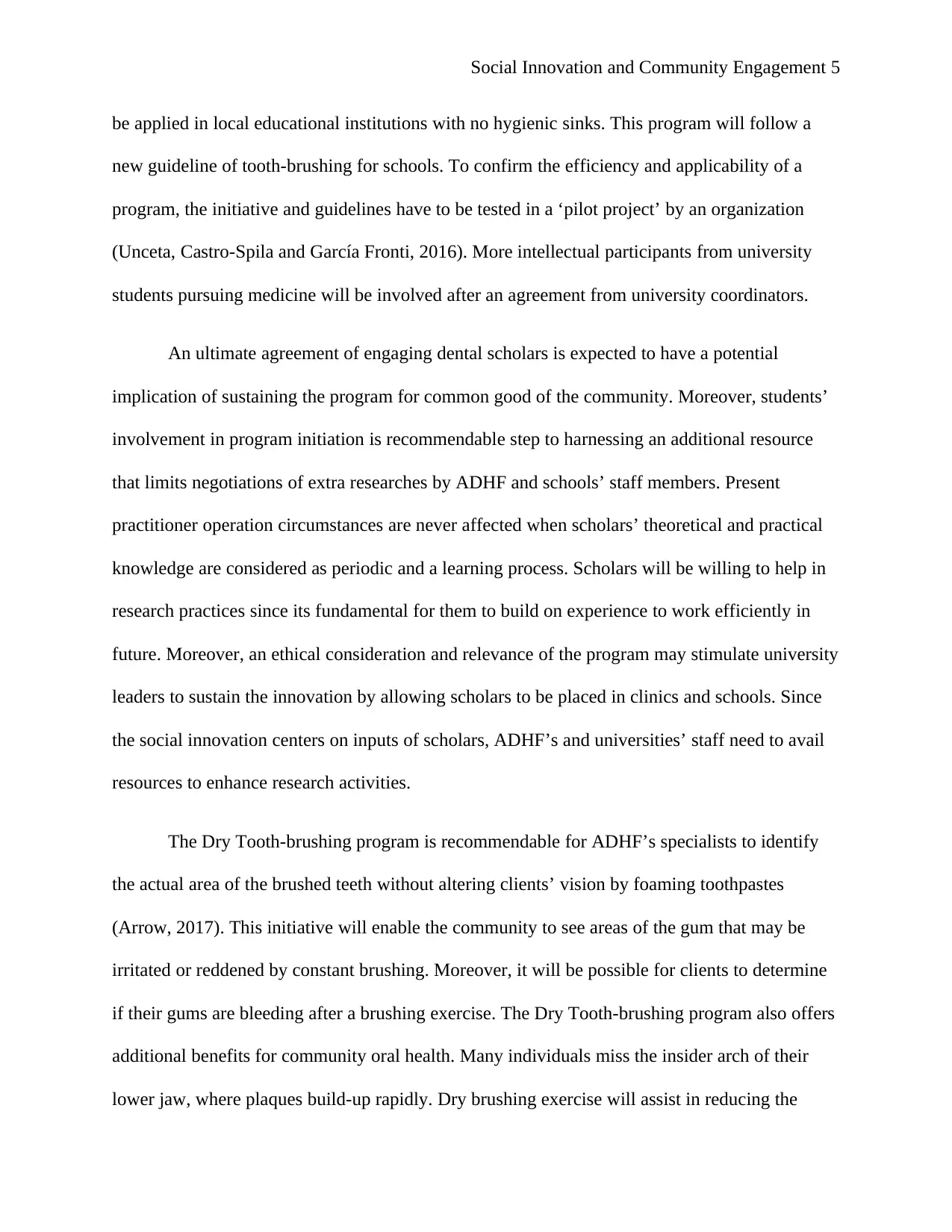
Social Innovation and Community Engagement 5
be applied in local educational institutions with no hygienic sinks. This program will follow a
new guideline of tooth-brushing for schools. To confirm the efficiency and applicability of a
program, the initiative and guidelines have to be tested in a ‘pilot project’ by an organization
(Unceta, Castro-Spila and García Fronti, 2016). More intellectual participants from university
students pursuing medicine will be involved after an agreement from university coordinators.
An ultimate agreement of engaging dental scholars is expected to have a potential
implication of sustaining the program for common good of the community. Moreover, students’
involvement in program initiation is recommendable step to harnessing an additional resource
that limits negotiations of extra researches by ADHF and schools’ staff members. Present
practitioner operation circumstances are never affected when scholars’ theoretical and practical
knowledge are considered as periodic and a learning process. Scholars will be willing to help in
research practices since its fundamental for them to build on experience to work efficiently in
future. Moreover, an ethical consideration and relevance of the program may stimulate university
leaders to sustain the innovation by allowing scholars to be placed in clinics and schools. Since
the social innovation centers on inputs of scholars, ADHF’s and universities’ staff need to avail
resources to enhance research activities.
The Dry Tooth-brushing program is recommendable for ADHF’s specialists to identify
the actual area of the brushed teeth without altering clients’ vision by foaming toothpastes
(Arrow, 2017). This initiative will enable the community to see areas of the gum that may be
irritated or reddened by constant brushing. Moreover, it will be possible for clients to determine
if their gums are bleeding after a brushing exercise. The Dry Tooth-brushing program also offers
additional benefits for community oral health. Many individuals miss the insider arch of their
lower jaw, where plaques build-up rapidly. Dry brushing exercise will assist in reducing the
be applied in local educational institutions with no hygienic sinks. This program will follow a
new guideline of tooth-brushing for schools. To confirm the efficiency and applicability of a
program, the initiative and guidelines have to be tested in a ‘pilot project’ by an organization
(Unceta, Castro-Spila and García Fronti, 2016). More intellectual participants from university
students pursuing medicine will be involved after an agreement from university coordinators.
An ultimate agreement of engaging dental scholars is expected to have a potential
implication of sustaining the program for common good of the community. Moreover, students’
involvement in program initiation is recommendable step to harnessing an additional resource
that limits negotiations of extra researches by ADHF and schools’ staff members. Present
practitioner operation circumstances are never affected when scholars’ theoretical and practical
knowledge are considered as periodic and a learning process. Scholars will be willing to help in
research practices since its fundamental for them to build on experience to work efficiently in
future. Moreover, an ethical consideration and relevance of the program may stimulate university
leaders to sustain the innovation by allowing scholars to be placed in clinics and schools. Since
the social innovation centers on inputs of scholars, ADHF’s and universities’ staff need to avail
resources to enhance research activities.
The Dry Tooth-brushing program is recommendable for ADHF’s specialists to identify
the actual area of the brushed teeth without altering clients’ vision by foaming toothpastes
(Arrow, 2017). This initiative will enable the community to see areas of the gum that may be
irritated or reddened by constant brushing. Moreover, it will be possible for clients to determine
if their gums are bleeding after a brushing exercise. The Dry Tooth-brushing program also offers
additional benefits for community oral health. Many individuals miss the insider arch of their
lower jaw, where plaques build-up rapidly. Dry brushing exercise will assist in reducing the
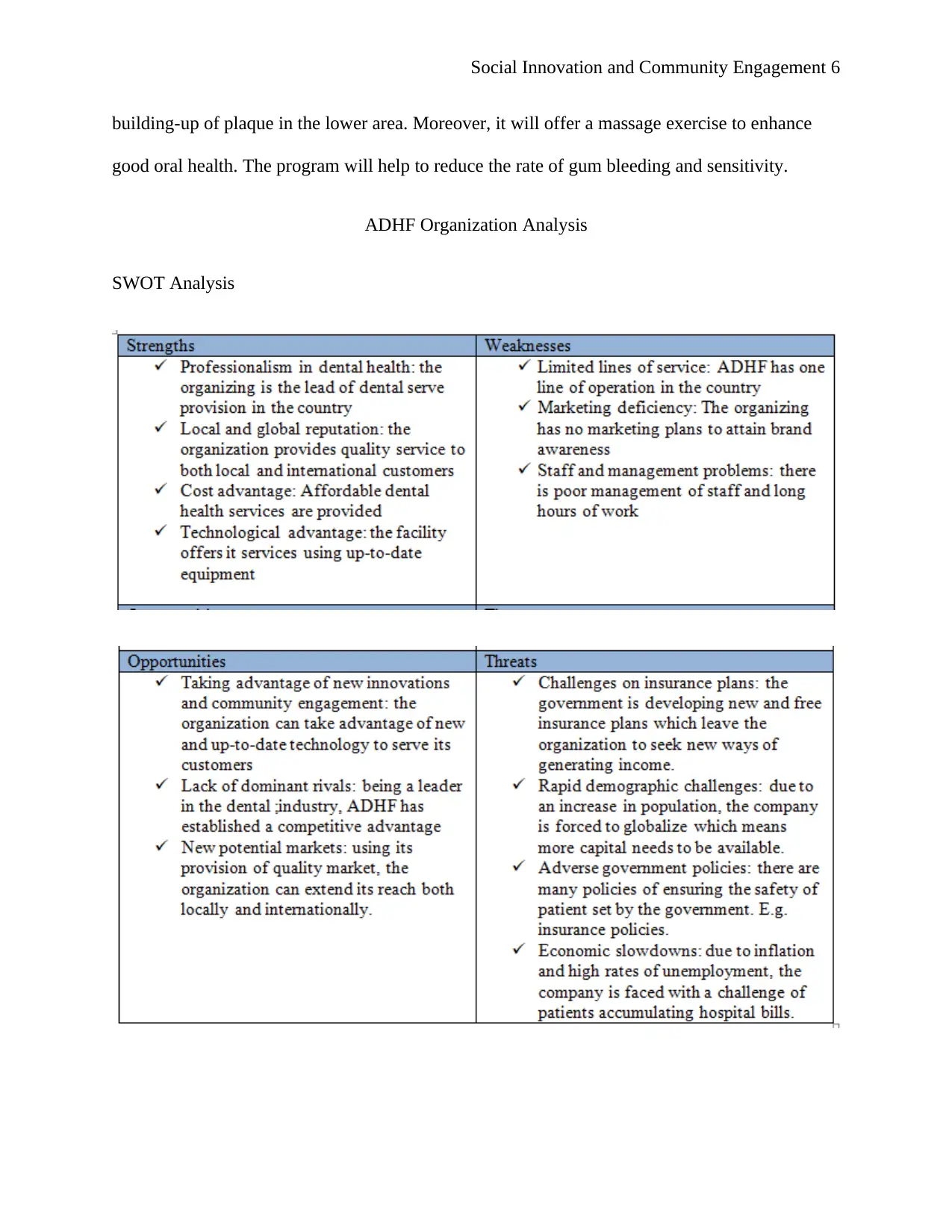
Social Innovation and Community Engagement 6
building-up of plaque in the lower area. Moreover, it will offer a massage exercise to enhance
good oral health. The program will help to reduce the rate of gum bleeding and sensitivity.
ADHF Organization Analysis
SWOT Analysis
building-up of plaque in the lower area. Moreover, it will offer a massage exercise to enhance
good oral health. The program will help to reduce the rate of gum bleeding and sensitivity.
ADHF Organization Analysis
SWOT Analysis
⊘ This is a preview!⊘
Do you want full access?
Subscribe today to unlock all pages.

Trusted by 1+ million students worldwide
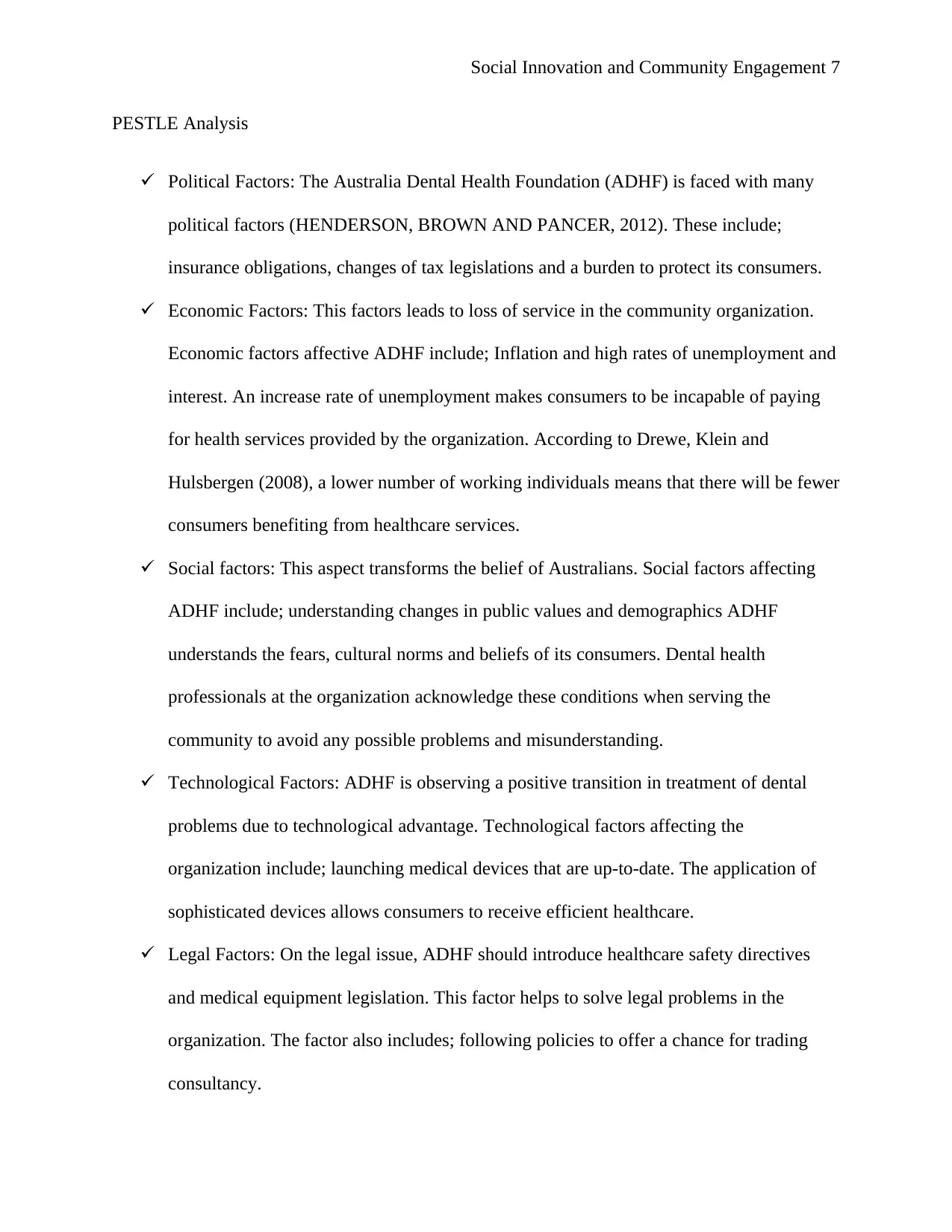
Social Innovation and Community Engagement 7
PESTLE Analysis
Political Factors: The Australia Dental Health Foundation (ADHF) is faced with many
political factors (HENDERSON, BROWN AND PANCER, 2012). These include;
insurance obligations, changes of tax legislations and a burden to protect its consumers.
Economic Factors: This factors leads to loss of service in the community organization.
Economic factors affective ADHF include; Inflation and high rates of unemployment and
interest. An increase rate of unemployment makes consumers to be incapable of paying
for health services provided by the organization. According to Drewe, Klein and
Hulsbergen (2008), a lower number of working individuals means that there will be fewer
consumers benefiting from healthcare services.
Social factors: This aspect transforms the belief of Australians. Social factors affecting
ADHF include; understanding changes in public values and demographics ADHF
understands the fears, cultural norms and beliefs of its consumers. Dental health
professionals at the organization acknowledge these conditions when serving the
community to avoid any possible problems and misunderstanding.
Technological Factors: ADHF is observing a positive transition in treatment of dental
problems due to technological advantage. Technological factors affecting the
organization include; launching medical devices that are up-to-date. The application of
sophisticated devices allows consumers to receive efficient healthcare.
Legal Factors: On the legal issue, ADHF should introduce healthcare safety directives
and medical equipment legislation. This factor helps to solve legal problems in the
organization. The factor also includes; following policies to offer a chance for trading
consultancy.
PESTLE Analysis
Political Factors: The Australia Dental Health Foundation (ADHF) is faced with many
political factors (HENDERSON, BROWN AND PANCER, 2012). These include;
insurance obligations, changes of tax legislations and a burden to protect its consumers.
Economic Factors: This factors leads to loss of service in the community organization.
Economic factors affective ADHF include; Inflation and high rates of unemployment and
interest. An increase rate of unemployment makes consumers to be incapable of paying
for health services provided by the organization. According to Drewe, Klein and
Hulsbergen (2008), a lower number of working individuals means that there will be fewer
consumers benefiting from healthcare services.
Social factors: This aspect transforms the belief of Australians. Social factors affecting
ADHF include; understanding changes in public values and demographics ADHF
understands the fears, cultural norms and beliefs of its consumers. Dental health
professionals at the organization acknowledge these conditions when serving the
community to avoid any possible problems and misunderstanding.
Technological Factors: ADHF is observing a positive transition in treatment of dental
problems due to technological advantage. Technological factors affecting the
organization include; launching medical devices that are up-to-date. The application of
sophisticated devices allows consumers to receive efficient healthcare.
Legal Factors: On the legal issue, ADHF should introduce healthcare safety directives
and medical equipment legislation. This factor helps to solve legal problems in the
organization. The factor also includes; following policies to offer a chance for trading
consultancy.
Paraphrase This Document
Need a fresh take? Get an instant paraphrase of this document with our AI Paraphraser
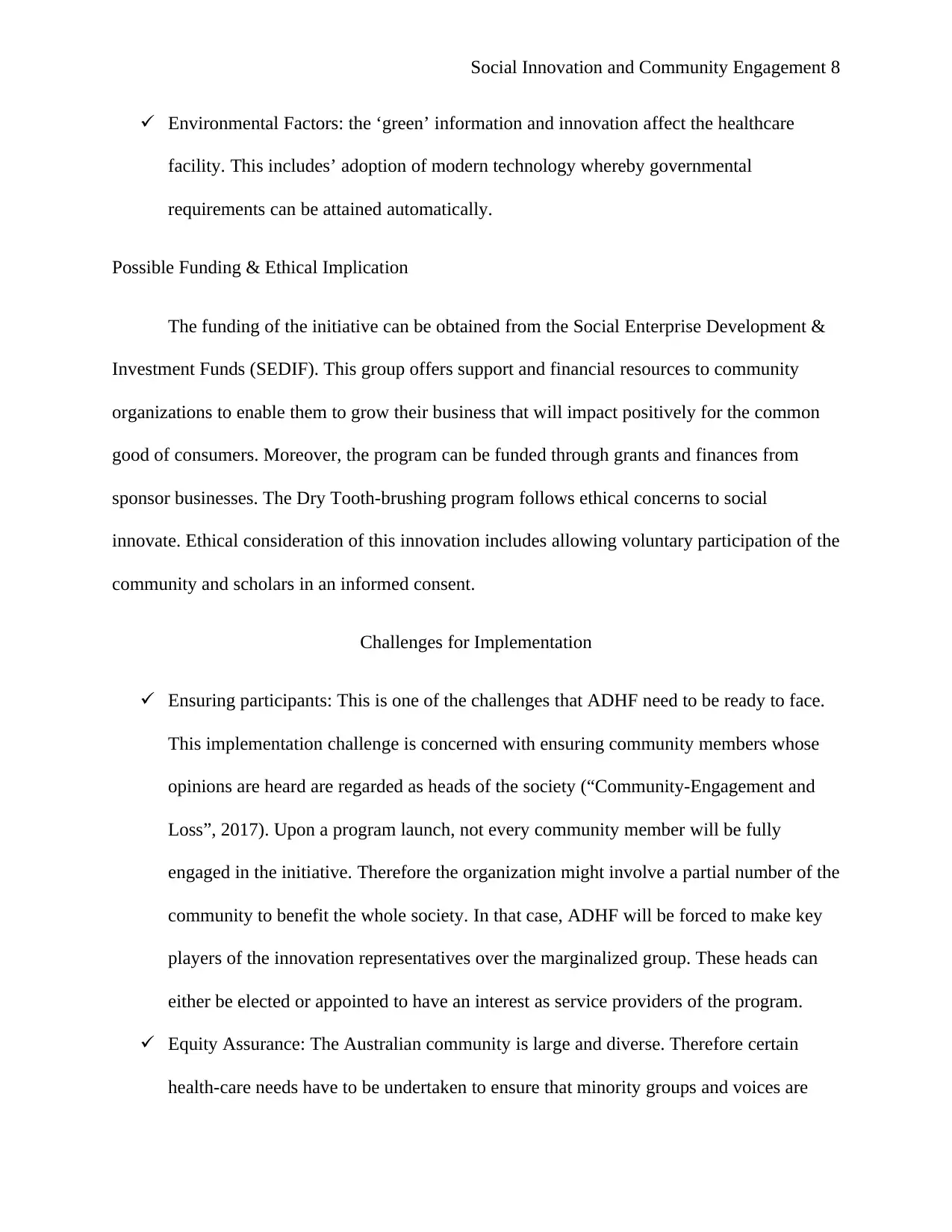
Social Innovation and Community Engagement 8
Environmental Factors: the ‘green’ information and innovation affect the healthcare
facility. This includes’ adoption of modern technology whereby governmental
requirements can be attained automatically.
Possible Funding & Ethical Implication
The funding of the initiative can be obtained from the Social Enterprise Development &
Investment Funds (SEDIF). This group offers support and financial resources to community
organizations to enable them to grow their business that will impact positively for the common
good of consumers. Moreover, the program can be funded through grants and finances from
sponsor businesses. The Dry Tooth-brushing program follows ethical concerns to social
innovate. Ethical consideration of this innovation includes allowing voluntary participation of the
community and scholars in an informed consent.
Challenges for Implementation
Ensuring participants: This is one of the challenges that ADHF need to be ready to face.
This implementation challenge is concerned with ensuring community members whose
opinions are heard are regarded as heads of the society (“Community-Engagement and
Loss”, 2017). Upon a program launch, not every community member will be fully
engaged in the initiative. Therefore the organization might involve a partial number of the
community to benefit the whole society. In that case, ADHF will be forced to make key
players of the innovation representatives over the marginalized group. These heads can
either be elected or appointed to have an interest as service providers of the program.
Equity Assurance: The Australian community is large and diverse. Therefore certain
health-care needs have to be undertaken to ensure that minority groups and voices are
Environmental Factors: the ‘green’ information and innovation affect the healthcare
facility. This includes’ adoption of modern technology whereby governmental
requirements can be attained automatically.
Possible Funding & Ethical Implication
The funding of the initiative can be obtained from the Social Enterprise Development &
Investment Funds (SEDIF). This group offers support and financial resources to community
organizations to enable them to grow their business that will impact positively for the common
good of consumers. Moreover, the program can be funded through grants and finances from
sponsor businesses. The Dry Tooth-brushing program follows ethical concerns to social
innovate. Ethical consideration of this innovation includes allowing voluntary participation of the
community and scholars in an informed consent.
Challenges for Implementation
Ensuring participants: This is one of the challenges that ADHF need to be ready to face.
This implementation challenge is concerned with ensuring community members whose
opinions are heard are regarded as heads of the society (“Community-Engagement and
Loss”, 2017). Upon a program launch, not every community member will be fully
engaged in the initiative. Therefore the organization might involve a partial number of the
community to benefit the whole society. In that case, ADHF will be forced to make key
players of the innovation representatives over the marginalized group. These heads can
either be elected or appointed to have an interest as service providers of the program.
Equity Assurance: The Australian community is large and diverse. Therefore certain
health-care needs have to be undertaken to ensure that minority groups and voices are
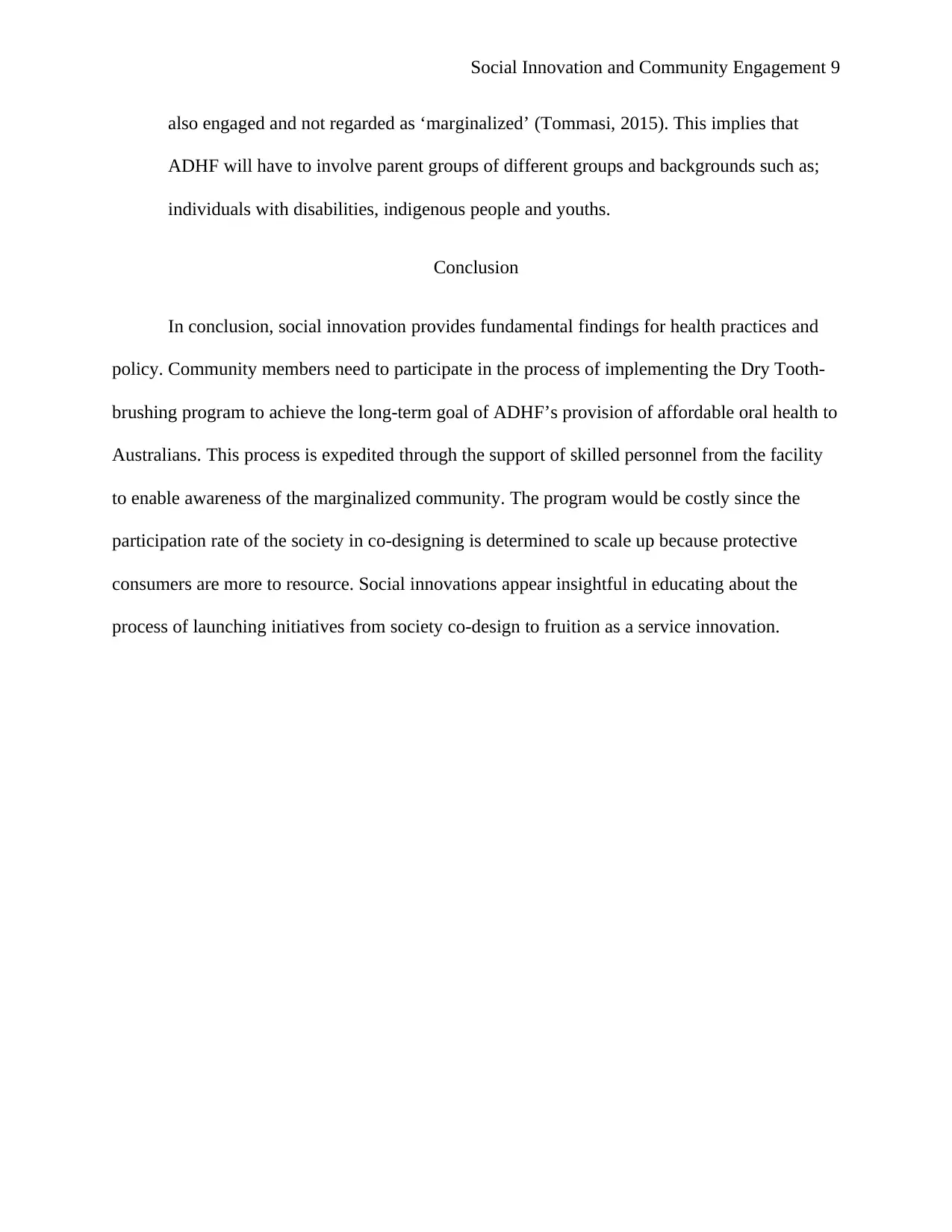
Social Innovation and Community Engagement 9
also engaged and not regarded as ‘marginalized’ (Tommasi, 2015). This implies that
ADHF will have to involve parent groups of different groups and backgrounds such as;
individuals with disabilities, indigenous people and youths.
Conclusion
In conclusion, social innovation provides fundamental findings for health practices and
policy. Community members need to participate in the process of implementing the Dry Tooth-
brushing program to achieve the long-term goal of ADHF’s provision of affordable oral health to
Australians. This process is expedited through the support of skilled personnel from the facility
to enable awareness of the marginalized community. The program would be costly since the
participation rate of the society in co-designing is determined to scale up because protective
consumers are more to resource. Social innovations appear insightful in educating about the
process of launching initiatives from society co-design to fruition as a service innovation.
also engaged and not regarded as ‘marginalized’ (Tommasi, 2015). This implies that
ADHF will have to involve parent groups of different groups and backgrounds such as;
individuals with disabilities, indigenous people and youths.
Conclusion
In conclusion, social innovation provides fundamental findings for health practices and
policy. Community members need to participate in the process of implementing the Dry Tooth-
brushing program to achieve the long-term goal of ADHF’s provision of affordable oral health to
Australians. This process is expedited through the support of skilled personnel from the facility
to enable awareness of the marginalized community. The program would be costly since the
participation rate of the society in co-designing is determined to scale up because protective
consumers are more to resource. Social innovations appear insightful in educating about the
process of launching initiatives from society co-design to fruition as a service innovation.
⊘ This is a preview!⊘
Do you want full access?
Subscribe today to unlock all pages.

Trusted by 1+ million students worldwide
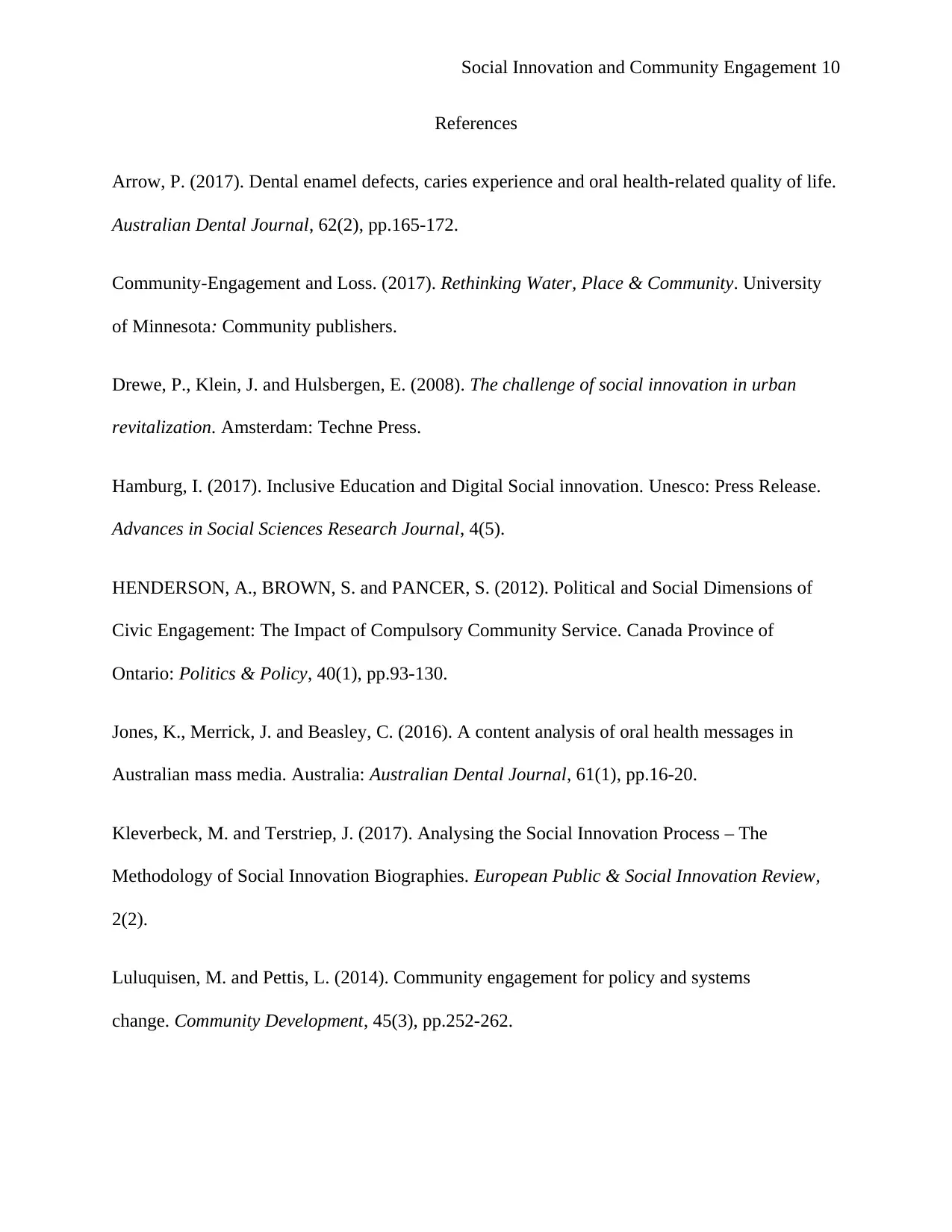
Social Innovation and Community Engagement 10
References
Arrow, P. (2017). Dental enamel defects, caries experience and oral health-related quality of life.
Australian Dental Journal, 62(2), pp.165-172.
Community-Engagement and Loss. (2017). Rethinking Water, Place & Community. University
of Minnesota: Community publishers.
Drewe, P., Klein, J. and Hulsbergen, E. (2008). The challenge of social innovation in urban
revitalization. Amsterdam: Techne Press.
Hamburg, I. (2017). Inclusive Education and Digital Social innovation. Unesco: Press Release.
Advances in Social Sciences Research Journal, 4(5).
HENDERSON, A., BROWN, S. and PANCER, S. (2012). Political and Social Dimensions of
Civic Engagement: The Impact of Compulsory Community Service. Canada Province of
Ontario: Politics & Policy, 40(1), pp.93-130.
Jones, K., Merrick, J. and Beasley, C. (2016). A content analysis of oral health messages in
Australian mass media. Australia: Australian Dental Journal, 61(1), pp.16-20.
Kleverbeck, M. and Terstriep, J. (2017). Analysing the Social Innovation Process – The
Methodology of Social Innovation Biographies. European Public & Social Innovation Review,
2(2).
Luluquisen, M. and Pettis, L. (2014). Community engagement for policy and systems
change. Community Development, 45(3), pp.252-262.
References
Arrow, P. (2017). Dental enamel defects, caries experience and oral health-related quality of life.
Australian Dental Journal, 62(2), pp.165-172.
Community-Engagement and Loss. (2017). Rethinking Water, Place & Community. University
of Minnesota: Community publishers.
Drewe, P., Klein, J. and Hulsbergen, E. (2008). The challenge of social innovation in urban
revitalization. Amsterdam: Techne Press.
Hamburg, I. (2017). Inclusive Education and Digital Social innovation. Unesco: Press Release.
Advances in Social Sciences Research Journal, 4(5).
HENDERSON, A., BROWN, S. and PANCER, S. (2012). Political and Social Dimensions of
Civic Engagement: The Impact of Compulsory Community Service. Canada Province of
Ontario: Politics & Policy, 40(1), pp.93-130.
Jones, K., Merrick, J. and Beasley, C. (2016). A content analysis of oral health messages in
Australian mass media. Australia: Australian Dental Journal, 61(1), pp.16-20.
Kleverbeck, M. and Terstriep, J. (2017). Analysing the Social Innovation Process – The
Methodology of Social Innovation Biographies. European Public & Social Innovation Review,
2(2).
Luluquisen, M. and Pettis, L. (2014). Community engagement for policy and systems
change. Community Development, 45(3), pp.252-262.
Paraphrase This Document
Need a fresh take? Get an instant paraphrase of this document with our AI Paraphraser
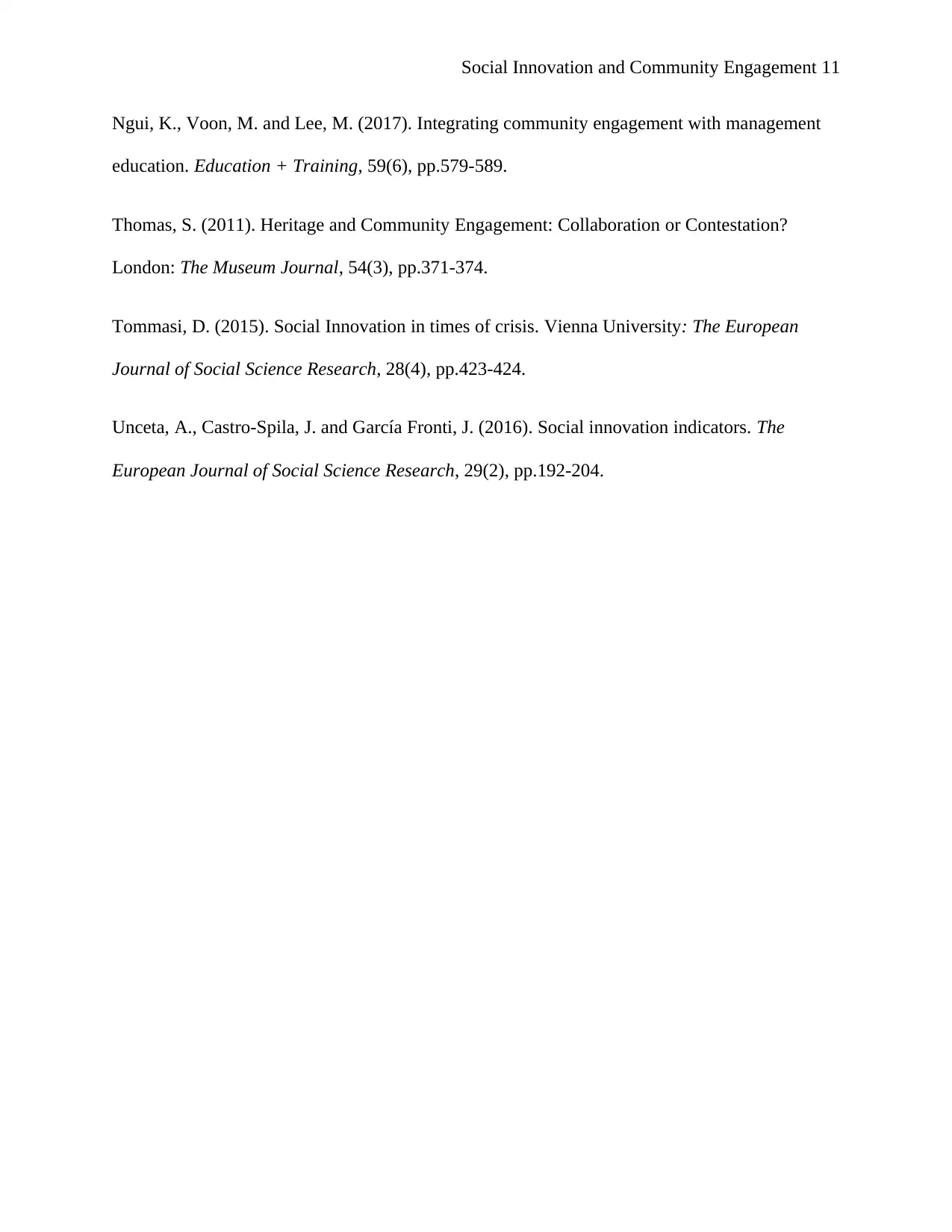
Social Innovation and Community Engagement 11
Ngui, K., Voon, M. and Lee, M. (2017). Integrating community engagement with management
education. Education + Training, 59(6), pp.579-589.
Thomas, S. (2011). Heritage and Community Engagement: Collaboration or Contestation?
London: The Museum Journal, 54(3), pp.371-374.
Tommasi, D. (2015). Social Innovation in times of crisis. Vienna University: The European
Journal of Social Science Research, 28(4), pp.423-424.
Unceta, A., Castro-Spila, J. and García Fronti, J. (2016). Social innovation indicators. The
European Journal of Social Science Research, 29(2), pp.192-204.
Ngui, K., Voon, M. and Lee, M. (2017). Integrating community engagement with management
education. Education + Training, 59(6), pp.579-589.
Thomas, S. (2011). Heritage and Community Engagement: Collaboration or Contestation?
London: The Museum Journal, 54(3), pp.371-374.
Tommasi, D. (2015). Social Innovation in times of crisis. Vienna University: The European
Journal of Social Science Research, 28(4), pp.423-424.
Unceta, A., Castro-Spila, J. and García Fronti, J. (2016). Social innovation indicators. The
European Journal of Social Science Research, 29(2), pp.192-204.
1 out of 11
Related Documents
Your All-in-One AI-Powered Toolkit for Academic Success.
+13062052269
info@desklib.com
Available 24*7 on WhatsApp / Email
![[object Object]](/_next/static/media/star-bottom.7253800d.svg)
Unlock your academic potential
Copyright © 2020–2025 A2Z Services. All Rights Reserved. Developed and managed by ZUCOL.




